Table of Contents
APPLIED BIOSTRATIGRAPHY
Supplementary notes to accompany the “Applied Biostratigraphy” course
About This Wiki
These Wiki pages are designed as a supplementary aid (a kind of “pre-written notebook”) to accompany the Applied Biostratigraphy course. As such it provides additional information on topics covered relatively briefly during the course, including the characteristics of the various microfossil groups, theory and tools for correlation and theory and tools for paleoenvironments. These topics are covered briefly during the course but time-constraints – particularly on the one-day course – do not allow as extensive a treatment as the authors would like. Nevertheless this information cannot provide a fully comprehensive treatment on these diverse subjects and attention is drawn to the reference list at the end of these pages and recommended references in the text for those who would like further detailed information and examples on these subjects.
An excellent introduction to the tools in the stratigrapher's toolbox (including biostratigraphy) is:
Coe, A.L. (ed.), 2022. Deciphering Earth's History: the Practice of Stratigraphy. The Geological Society of London, 349pp.
Content of these notes are provided by Mike Bidgood (GSS Geoscience Ltd.), Dave Jutson (Independent Consultant), Emma Sheldon (GEUS), Mike Simmons (Halliburton) and Matt Wakefield (Lealt Stratigraphic Consultants Ltd.)
Introduction
Setting the Scene What is Applied Biostratigraphy?
Sample Processing & Sample Selection
Recording and Managing Data – Automation In Biostratigraphy
Biostratigraphy in the Exploration & Production Workflow
Biostratigraphy was frequently thought of as a “Cinderella science” in the industry due to a number of factors with the main one being its relative inaccessibility to non-specialists. Biostratigraphers were often seen as rather detached, “academic” types, obsessed with minutiae and generally “not interested” in the practical applications of the subject – and in some cases this was true! Biostratigraphers were seldom consulted during the everyday process of exploring, developing and producing resources and tended to be brought in only to help solve immediate geological problems.
Paradigms began to shift in the 1990s, especially with the advent of sequence-based stratigraphic analysis. In the late 1990s in the introduction to proceedings of a major industry conference, J R Parker, Chief Geologist at Shell, wrote…
“The emphasis on sequence stratigraphy marks the welcome return of stratigraphy to what I believe is its rightful place as the central discipline of geology.… It is also evident that a knowledge of the underlying biostratigraphic framework is crucial for the understanding, testing and application of such schemes.”
One can scarcely ask for a better and more succinct endorsement of the importance of applied biostratigraphy and sequence stratigraphy.
The idea of more integration of biostratigraphy into E&P workflows began to gain ground, both in the areas of frontier exploration (“basin screening”) as a means of providing well-calibrated sequence stratigraphic frameworks and in the field development and production phases as a means of detailed stratigraphic analysis and innovative uses to solve operational (drilling) problems.
Biostratigraphy; the Energy Transition and Other Applications
The use of biostratigraphy in situations connected with the Energy Transition (or for other non-hydrocarbon applications) are, unsurprisingly, still in the early days and published examples are rare. However, it is important to realise one fundamental point…
The principles of correlation, environmental determination and sequence prediction enabled by biostratigraphy and learned over a century of work in the hydrocarbon industry are equally and necessarily applicable in the Energy Transition.
- This means that screening basins for aquifers for CCUS (Carbon Capture, Utilisation & Storage) purposes relies as much on biostratigraphy for correlation, paleoenvironmental determination and sequence prediction as it did when screening for source, reservoir and seal rocks.
- This means drilling a borehole for CCUS, or perhaps even geothermal purposes, requires the same wellsite engineering/safety/geological control/biosteering functions as drilling a wildcat or general hydrocarbon production well.
- This means siting an offshore multi- wind turbine farm requires the mapping of recent and ancient environmental units to avoid unsuitable foundation strata in the same way that GDE maps help to establish play-fairways.
CCUS in Denmark: The Stenlille Structure, a model for future CO2 Storage
Geothermal Energy and Biostratigraphy - examples from Denmark
Drinking Water and Biostratigraphy (Aquifers) - an example from Denmark
Civil Engineering Projects - tunnels etc.
The Major Microfossil Groups
There are many, many kinds of microscopic organisms that have a fossil record and equally as many specialists who study them. All are potentially useful biostratigraphic tools but it is fair to say that some types are more useful (and more widely studied) than others. These can be grouped to three very broad categories - microfossils, nannofossils and palynomorphs - depending on their relative sizes, the composition of their fossilisable parts, and (to a surprisingly important extent) the method(s) used to extract them from the surrounding rock in order to study them.
Within these broad groups, some fossil types are, again, more useful than others in applied biostratigraphy.
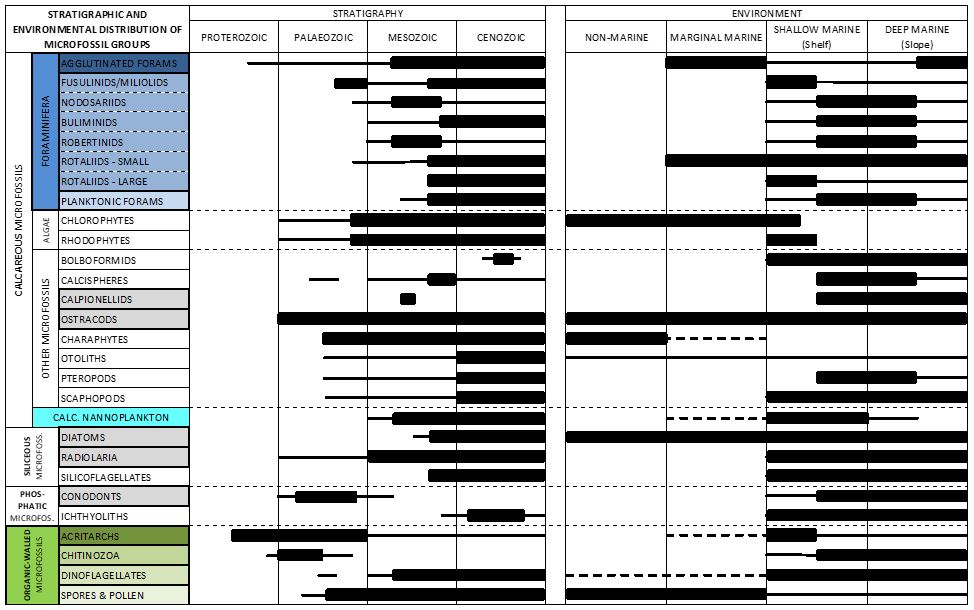
A summary of the broad stratigraphic and environmental distribution of the main microfossil groups (coloured and shaded boxes are of microfossils discussed in this Wiki)
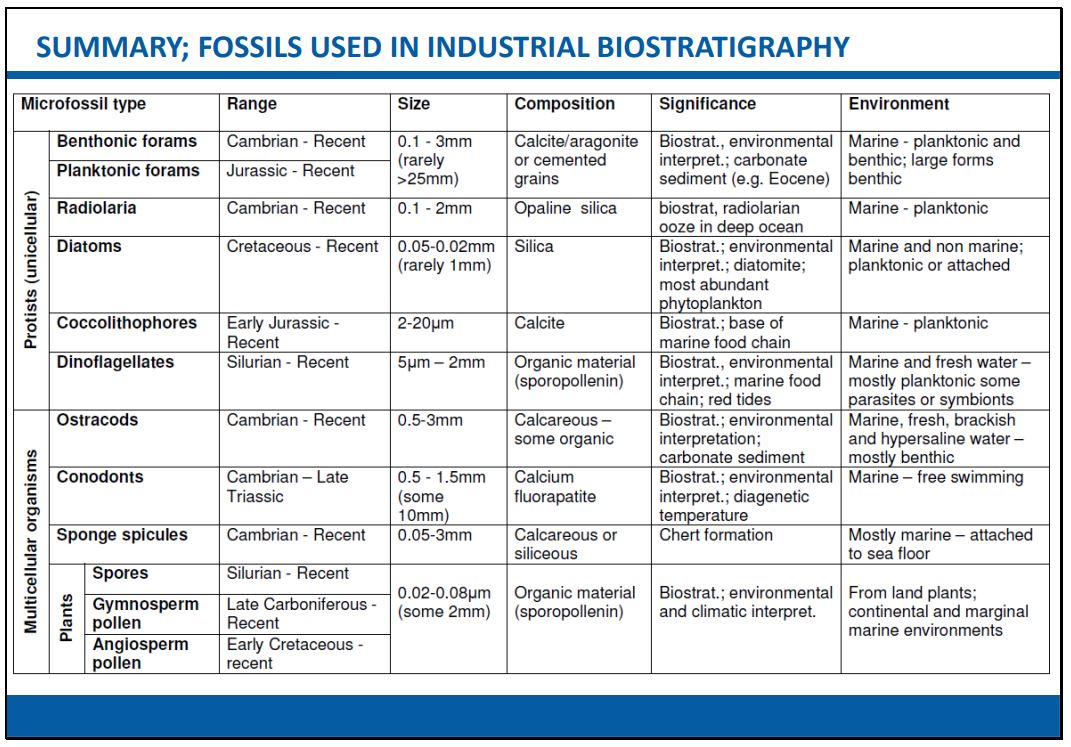
A summary of the various fossil groups often encountered in Applied Biostratigraphy
Microfossils
The informal term “microfossils” refers to a diverse group of organisms, from both the plant and animal kingdoms, of a size which requires the use of a medium-powered microscope capable of magnifying around 100-150x. Most fossil specimens are around 0.25-1.00mm in size but some may be larger (up to several centimetres). They are normally examined whole by incident (reflected) light but occasionally transmitted light is used to study thin-sections which can show internal structures.
The processing of microfossils for examination normally involves their separation from the surrounding sediment by attempting to disaggregate the sediment and washing away the mud or fine silt fractions. Some specimens (particularly “larger” foraminifera and those microfossils embedded in hard limestones) may be examined in situ by producing a thin-section of the sample.
The term “microfossils” encompasses a wide range of (mainly) animal and plant types which have (a) a common size and (b) useful geological utility. The most common group studied by biostratigraphers in this major category are the Foraminifera (often informally “Forams” and, even less formally by some - “bugs”!) and it is the Foraminifera which form the emphasis for microfossil studies in this course.
Nannofossils
The term “nannofossils” refers to a group of organisms of a size which require the use of a high-powered microscope capable of magnifying around 1000-1500x. Most fossil specimens are around 2-20 microns in size. They are normally examined in thin section preparation by transmitted light with polarisers and a “slow wave” plate.
The processing of nannofossils for examination normally involves the sediment being mixed with water and spread or ‘smeared’ onto the surface of a microscope slide, dried and then covered with a coverslip attached with an optical adhesive. There is a standard preparation method, but most nannopaleontologists have their own adaptations for coping with the variety of lithologies that they encounter at wellsite.
The term “nannofossils” encompasses a wide range of plant derived fossils which have (a) a common size and (b) significant geological utility. These may include coccoliths, nannoconids, pentalithssphenoliths, discoasters and even calcareous dinoflagellate cysts. However, coccoliths, nannoconids and discoasters are the predominant types found in this particular group and are often grouped together under the term “Calcareous Nannoplankton”.
Palynomorphs
Palynomorphs are of a comparable size to Nannofossils and require examination by microscopes of similar power (1000x - 1500x). Palynomorphs have different origins from several biological and botanical groups but are grouped by geologists as “palynomorphs” based on their common property of having an organic, non-mineralised, cell or body wall (dinosporin for dinoflagellates and ?acritarchs, sporopollenin for spores and pollen and “pseudochitin” for chitinozoa and ?tintinnids).
Many palynomorphs can be resistant to damage during post-mortem transport – the organic wall confers both strength and flexibility compared with hard and brittle mineralised shells of other fossil groups - allowing the organism to enter the fossil record even in relatively high energy deposits (e.g. sands).
The liberation of organic-walled microfossils requires specialised, potentially hazardous, processing techniques and chemicals to isolate fossil specimens. In effect, the rocks must be dissolved away from the palynomorph fossils by a combination of strong acids and the palynomorphs oxidised to make them visible in sample slides. The most commonly studied palynomorphs in applied biostratigraphy are the Dinoflagellates and Spores & Pollen.
Dinoflagellates and Acritarchs
Other "Fossil Stuff"
This section contains information on the details of how paleontologists think and work, particularly regarding how fossils are identified and named and why those names often change. This is a very specialised topic and can be ignored by most users unless specifically interested.
The Naming of Fossils: Taxonomy
Stratigraphy and Correlation
The study of how rocks are categorised, subdivided and correlated. There are numerous ways to do this, the most common and familiar being categorised by (i) rock type = lithostratigraphy (ii) time interval = chronostratigraphy and (iii) fossil content = biostratigraphy. However there are a large number of other tools for correlation including isotopes (= isotopic stratigraphy sometimes also known as chemostratigraphy), magnetic susceptibility (= magnetostratigraphy), geophysical logs (= log stratigraphy), seismic characteristics (= seismic stratigraphy) and many others.

William Smith (above) is often revered as the “father of stratigraphy”, although others before him also contributed to the birth of the subject e.g. Nicholas Steno 150 years earlier with his principles of stratigraphy (original horizontality, original continuity, superposition and cross cutting relationships); and even, among others, Leonardo da Vinci. While surveying canal routes Smith (1815) theorised that rock layers occurred in predictable patterns identified by their fossils i.e. faunal succession, and published a geological map of England and Wales. William Smith’s maps, and those he produced of smaller areas from 1799, were arguably the first to use stratigraphical principles and also highlighted resources of contemporary societal importance (coals).
An excellent introduction to the tools in the stratigrapher's toolbox is:
Coe, A.L. (ed.), 2022. Deciphering Earth's History: the Practice of Stratigraphy. The Geological Society of London, 349pp.
Chronostratigraphy – Geological Time Scales; Trouble in Paradise
Biostratigraphy and Biozonation
How do we use biozones? - Correlation
High Resolution Biostratigraphy
Paleoenvironments
Often in the Geoscientist's workflow it is as important to know the (paleo)environment of deposition (EOD) of the rock types likely to be encountered in a particular basin as it is to know the stratigraphy. Knowledge of such EODs can be of great predictive value in the distribution and mapping of source, reservoir and caprock units in a basin.
Recognising vertical and lateral changes in paleoenvironments are critical inputs into sequence stratigraphic interpretation.
Interpreting Paleoenvironments from Fossils
The Biology & Distribution of Microfossils
Typical Environments and Their Fossils
Paleoenvironments and Sequence Biostratigraphy
Maturity Studies and Fossils
In order to generate hydrocarbons in commercial quantities, organic matter within the source-rock must be “cooked” enough to generate and release hydrocarbons. The organic material can be of various types and origins but, despite popular belief, oil is not made up from the remains of dinosaurs!
“Cooking” is dependent upon heat-flow from the earth and the depth of burial of the organic-rich sediment. Hydrocarbons begin to be generated and released at temperatures of around 50 degrees C. This marks the beginning of a phase of oil and wet-gas generation called Catagenesis. Temperatures below this level are as the result of processes linked with Diagenesis. At temperatures characterising Diagenesis only bacterial gas can be generated. At temperatures above 175 degrees C only methane (dry gas) can be generated. This is termed Metagenesis.
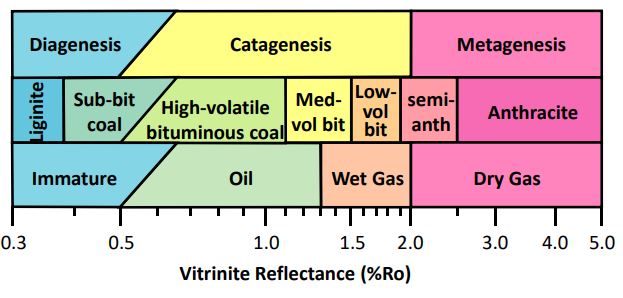
Catagenesis temperatures can be achieved at relatively shallow depths in basins with high heat-flow and deeper in those with lower heat-flow. Organic matter is said to posses various degrees of Maturity depending on its temperature history.
Many fossils also respond to temperature changes after burial which involves a corresponding change of colour. Fossils with an organic wall are most prone to this effect but it can appear in other, mineralised fossils too. By measuring the colour of the fossil (often subjectively by comparing with “standard” colours but sometimes automatically) degrees of thermal maturity can be assessed.
Source Rocks and Kerogen Types
Thermal Maturity and Microfossils
Sequence Biostratigraphy
Sequence Biostratigraphy - or the role played by “classical” biostratigraphic techniques in sequence analysis - is one of the most exciting developments in the science in recent decades. Biostratigraphy provides two critical inputs into sequence analysis. It can…
- be used to correlate sequence surfaces (sequence boundaries, flooding surfaces etc.) thus proving their synchronicity
- be used to “fingerprint” and therefore identify the nature of the sediments between the various surfaces
The use of biostratigraphy in the specific identification of sequence surfaces and components is relatively new although, in fact, biostratigraphers have been identifying such features in their data for a long time but not necessarily appreciating their sequence applications. Like many of the concepts for sequence stratigraphy itself, sequence biostratigraphy first became prominent in the Gulf of Mexico (Armentrout, 1993, 1996) but has since expanded into other areas such as the North Sea (Partington et al., 1993; Neal et al., 1994) and the Arabian Platform (Sharland et al., 2001; Simmons et al., 2007) and others.
Sequence Biostratigraphy brings together more or less all the individual analytical and interpretive techniques covered in the course and builds it into a coherent, fully integrated synthesis of the depositional history of a basin.
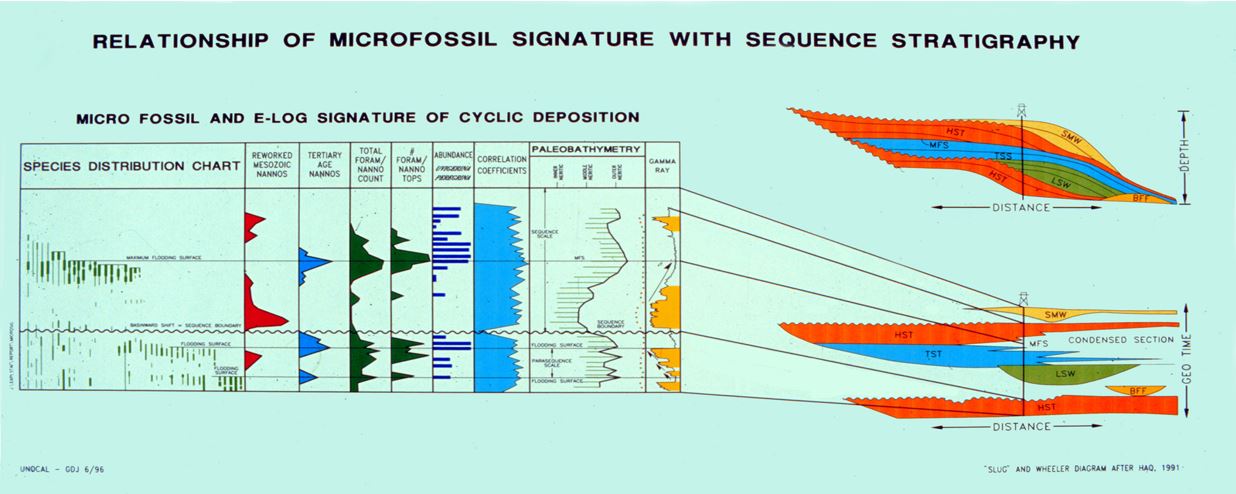
Analysing patterns in biostratigraphic data can help identify sequence components like sequence boundaries, maximum flooding surfaces and different depositional systems tracts. Moreover, biostratigraphy can help confirm the synchronicity of events observed in different locations.
It is within the scope of Sequence Stratigraphy that the full range of biostratigraphic principles and techniques are integrated and realised. Without the correlative power of biostratigraphy, events related to different phases within sea-level cycles cannot be deemed synchronous, and without insights into paleoenvironments determined by fossils it would be very difficult to interpret the nature of the systems tracts that are the building blocks of sequences.
A discussion of all the concepts for sequence stratigraphy and biostratigraphy is beyond the scope of this manual, but the essence of the subject is that by using a variety of data manipulation techniques and pattern recognition, together with basic stratigraphic principles, it is possible to link characteristic biostratigraphic features and trends with particular sequence surfaces and components (systems tracts).
Why is sequence stratigraphy important?
Characterising sequence components using fossils
The Sequence Boundary (SB) and Correlative Conformity (CC)
Maximum Regressive Surface (MRS)
Transgressive Systems Tract (TST)
Maximum Flooding Surface (MFS)
Highstand Systems Tract (HST) and Summary
Operational Biostratigraphy
The relatively simple equipment and consumables requirements for biostratigraphy (basically some sample processing equipment and a microscope) lends itself to use at remote drilling locations, both on and offshore.
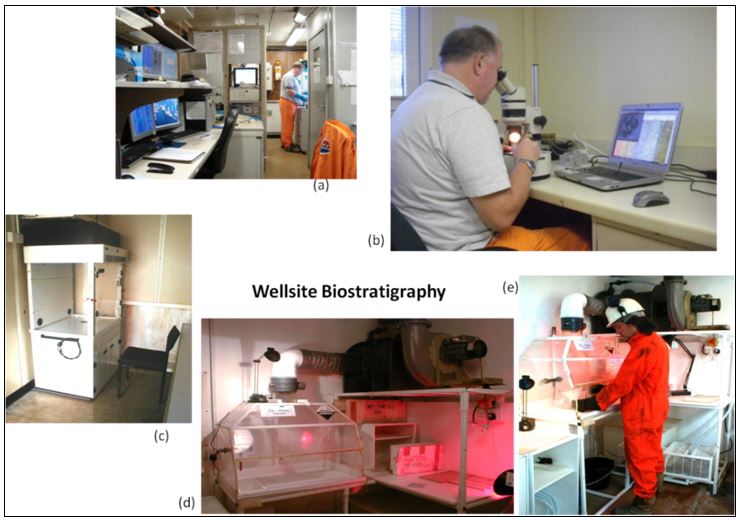
(a) Wellsite biostratigrapher processing a sample in a mudlogging cabin; (b) the biostratigrapher examining and logging the sample in the geologist's office; (c & d) processing equipment (fume cupboards and chemical scrubbing gear) in a wellsite palynological laboratory with (e) the sample processing technician.
Wellsite biostratigraphy (as it is commonly termed) can be used in operations that enhance geological interpretations in real-time and which improves strategic decisions involving
- Safety
- Engineering
- Costs
Essentially, the wellsite biostratigrapher assists drilling in the following ways and can add substantial dollar value to assets:
- Geological monitoring
- “Geostopping” (horizon identification)
- “Biosteering” (optimising borehole trajectory)
Requirements for Biostratigraphy at the Wellsite
Sources
Copyright and Permissions
This Wiki site and the accompanying teaching materials are the property of the authors and may not be sold, copied, modified or distributed without permission of the authors. No material (included but not limited to: text, figures, tables, charts etc.) may be used in derived matter (publications, presentations, submissions etc.) without the permission of the authors. Notwithstanding the above, the authors are very keen to introduce, promote and expand the awareness and use of biostratigraphy in applied settings and are likely to look very favourably upon such requests. Please contact Mike Bidgood in the first instance (mike(at)gssgeoscience[dot]co[dot]uk).